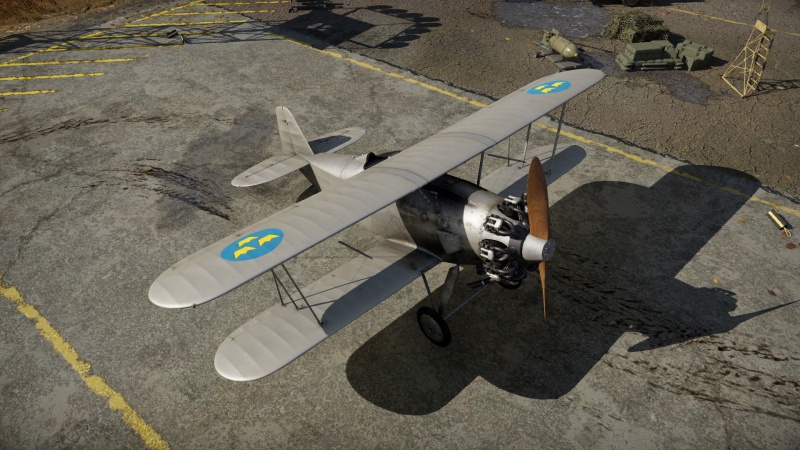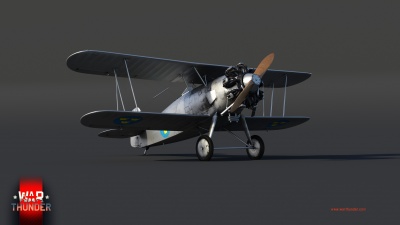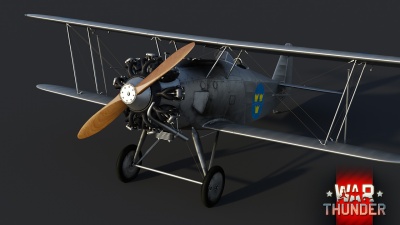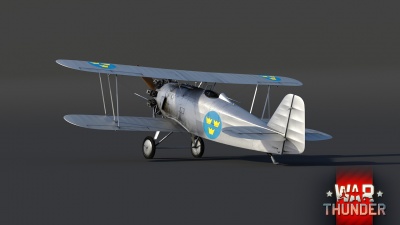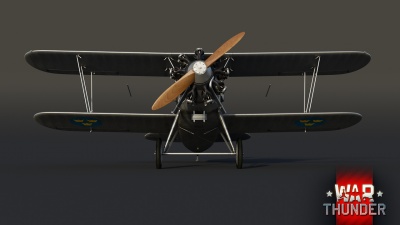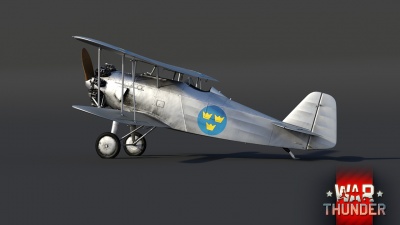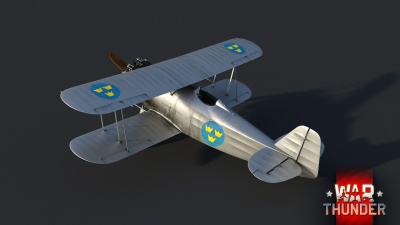J6B
Contents
Description
Designed and manufactured in Sweden during the early 1930s, the J6B biplane fighter was the last biplane fighter to be designed in Sweden and the last variant of its series to be built. It was manufactured by ASJA from 1933 to 1935, but the core-design was originally constructed by Svenska Aero AB, which was purchased by ASJA in 1932. The J6B served as a fighter aircraft in the Swedish air force between 1934 to 1938 and as a fighter-trainer from 1938 to 1940. Two J6Bs were sent to Finland as war aid during the Winter War. In Finland, they were designated JF, and served as trainers until 1945.
It was introduced in Update 1.95 "Northern Wind", and though not a speedy aircraft compared to other reserve aircraft in the game, the J6B features extremely good manoeuvrability and two nose-mounted 8 mm fast-firing machine guns which makes it extremely deadly in a skilled pilot's hands, but at the same time, also very forgiving to the new player. It has access to several ammunition belts which allow the J6B to effectively fight both air and ground targets in air RB. The aircraft might not look impressive on paper, but any pilot with basic air combat knowledge can easily prove that this biplane fighter is no slouch. The great climb rate and manoeuvrability, in combination with some creativity, is all you need to perform and exceed in this aircraft
General info
Flight performance
| Characteristics | Max Speed (km/h at 3,000 m) |
Max altitude (metres) |
Turn time (seconds) |
Rate of climb (metres/second) |
Take-off run (metres) | |||
|---|---|---|---|---|---|---|---|---|
| AB | RB | AB | RB | AB | RB | |||
| Stock | 311 | 298 | 14.4 | 15.0 | 13.8 | 13.8 | 294 | |
| Upgraded | 343 | 325 | 13.0 | 13.7 | 20.3 | 16.6 | ||
Details
| Features | ||||
|---|---|---|---|---|
| Combat flaps | Take-off flaps | Landing flaps | Air brakes | Arrestor gear |
| X | X | X | X | X |
| Limits | ||||||
|---|---|---|---|---|---|---|
| Wings (km/h) | Gear (km/h) | Flaps (km/h) | Max Static G | |||
| Combat | Take-off | Landing | + | - | ||
| N/A | N/A | N/A | ~13 | ~6 | ||
| Optimal velocities (km/h) | |||
|---|---|---|---|
| Ailerons | Rudder | Elevators | Radiator |
| < 250 | < 200 | < 320 | > 170 |
Survivability and armour
- No armour plating
- No armour glazing
- Critical components located in front of aircraft (fuel, pilot, engine, controls)
Like many aircraft just prior to the outbreak of World War II, the J6B was not outfitted with any armour plating. The J6B was designed during a time period when armour was not seen as viable, due to its added weight. The added weight of armour lowered climb-rate, speed, manoeuvrability, and range greatly due to the low power of most biplanes. Armour first started to appear during the later stages of the 1930s.
To maintain the centre of balance for this fighter, the pilot, fuel tank and engine take up the fuselage from the middle to the front. Any attacks on this aircraft in this zone risk hitting a critical component, ending the J6B's fight in the battle earlier than expected. With an open cockpit, fabric coverings and a mediocre engine, the survivability of this aircraft, for the most part, rests in the pilot's hands and their ability to out-fly the enemy pilots.
Modifications and economy
Armaments
Offensive armament
The J6B is armed with:
- 1 x 8 mm Ksp m/22 Fh (fixed right) machine gun, nose-mounted (500 rpg)
- 1 x 8 mm Ksp m/22 Fv (fixed left) machine gun, nose-mounted (500 rpg)
The Swedish Air Force chose to outfit the J6B with license-built copies of the FN Browning M1919 air cooled aircraft machine gun. These were designated kulspruta m/22 (originally flygplankulspruta m/22), or ksp m/22 for short, in Sweden and were originally chambered for the Swedish 6.5x55 m/94 cartridge. But as this cartridge was seen as too weak against aircraft by 1930, a more powerful 8x63 mm cartridge was introduced in 1932. This cartridge, which went under the designation 8 mm sk ptr m/32 (8 mm skarp patron m/32 - 8 mm live cartridge m/32), was extremely powerful compared to similar cartridges around the world.
Gun placement
Both guns are mounted in the upper cowling and fire synchronized through the propeller arc. This makes it very easy to aim with the J6B, as the bullets always flies in the same line as the aircraft. Aircraft with wing mounted guns are much harder to aim, as they have to deal with convergence calculations to hit aircraft. Bullet drop over distance is still a consideration.
Typically in biplanes, the most effective range for disabling or destroying another aircraft is around 100 to 250 m, although reliable damage can be sent out to 600 m or more with a potent pilot. Many ace pilots from all sides of the war stated that when the enemy filled the windscreen, there was no way you could not hit, thereby guaranteeing a hit and conserving ammunition.
Effect
The fire-rate of the J6B's guns are an above-average 1,200 rounds per minute. This is an ideal fire rate, as it is high enough to deal a high amount of damage per minute, but at the same time allow for longer bursts of fire before overheating. The ammunition amount of 500 rounds per gun is also within the ideal for this fire rate. 1,200 rounds per minute means 20 shots per second which in return means that it takes 25 seconds to fire through a full magazine. 25 seconds is more than enough for 4-5 kills if all shots connect. The average burst time before the guns starts to overheat is about 5-6 seconds, which is more than enough time to tear a plane apart.
Belts
The J6B has access to 7 belt types. The default belt and ground target belts are effectively the same, as they use the same composition of bullets, except that the order is different. Due to this, there is no reason to use the ground targets belts. The same deal goes for the universal belt and air targets belt. They both share the same composition of bullets, just in a different order.
There are 4 belts which are of use for the average player.
- Tracers: This belt is very effective against other biplanes, especially those that have fabric coverings and non-self-sealing fuel tanks. Tracer bullets, due to their phosphor tracer load, have a good chance of setting unprotected planes on fire. This is a good combination at rank I, as a lot of planes lack self-sealing fuel tanks.
- Air targets/Universal: These belts contain 1 tracer bullet, one armour-piercing bullet and 2 incendiary bullets. As noted previously the tracer bullets are good at setting biplanes on fire. The incendiary bullets are good at setting full-metal monoplanes on fire.
- Stealth: These belts lack a tracer bullet and only consist of armour-piercing and incendiary. Due to this they are ideal for attacking unsuspecting targets, as they cannot see the strings of bullets flying out from your machine guns. On the other hand, neither can you. The way to use stealth is to know the projectile paths by heart so you can calculate the trajectory without tracers. A lot of seasoned players uses stealth belts as they find tracers annoying and misleading.
- Armoured targets: This belt apparently uses tungsten bullets instead of steel. This gives it an impressive penetration of 18 mm at 500 m. This is enough to penetrate some light tanks from the side or from the top. Although, the bullets do minor damage at best. It is possible to engage light pillboxes and light tanks with this belt, unlike the rest.
Usage in battles
The J6B is one of Sweden's reserve aircraft, it is a great introduction to the Swedish aviation tree and it is able to compete with other planes. Like most other reserve aircraft, it lacks speed, armour protection and firepower.
The J6B can be used like any other biplane, thanks to its good manoeuvrability. The J6B takes a while to get to the desired speed to be manoeuvrable enough to repel attackers. It might look like an easy prey, but the J6B's Ksps machine guns are powerful and can make even enemy aircraft at higher BRs regret their decision.
Most notable enemies to be aware of are the He 100 D-1, the I-16, the I-153 M-62, the Ki-43 and the H-75A-4.
Ground Battles
The J6B is effective in ground battles. The 8 mm Ksp m/22 pack a hard punch, having a great penetration capability of 18 mm at 500 m, and 20 mm at 100 m making it a decent at ground battles being able to keep up with the M2 Browning in the early tiers, in terms of penetration power. That is useful against enemy tanks that have a lightly-armoured top, making them easy targets for the J6B to attack the tank's roof weak spots. The J6B is relatively slow, making it an easy target for low-tier SPAA like M13 MGMC, P.7.T AA and Flakpanzer I.
Manual Engine Control
| MEC elements | ||||||
|---|---|---|---|---|---|---|
| Mixer | Pitch | Radiator | Supercharger | Turbocharger | ||
| Oil | Water | Type | ||||
| Controllable | Not controllable Not auto controlled |
Not controllable Not auto controlled |
Not controllable Not auto controlled |
Separate | Not controllable 1 gear |
Not controllable |
Pros and cons
Pros:
- Great handling characteristics
- Good climb rate
- Nose mounted armament
- High rate of fire for main guns
- Large ammunition amount
- Large choice of ammunition belts for main guns
- Self-sealing fuel tanks
Cons:
- Below-average speed near the ground, slow level flight
- Weak armament against full metal aircraft
- Unprotected engine
History
The J6B is a Swedish designed and manufactured biplane fighter from the early 1930s. It was the last biplane fighter to be designed in Sweden and the last version of its aircraft-model to be built. Its designer and manufacturer, AB Svenska Järnvägsverkstädernas Aeroplanavdelning (The Swedish iron-works aeroplane department Ltd)(ASJA for short), acquired the base-model when they bought the company Svenska Aero AB (Swedish Aero Ltd)(SA for short) in 1932. Svenska Aero AB had designed and manufactured 3 previous iterations of the J6B during a 4-year period prior to their acquisition by ASJA in 1932.
To get a good understanding of the J6B's history it is necessary to tell the history of its original designer, Svenska Aero AB as well as its previous iterations.
Svenska Aero AB
Svenska Aero AB was founded in 1921 as a response to the limitations put on the German aviation industry after WWI. Germany was not allowed to export military aircraft which led to a lot of German aviation companies and engineers to move work abroad. One of these were the German pilot and aviation-enthusiast Carl Clemens Bücker, known today for his popular WWII trainer aircraft such as the Bü 131 och Bü 133.
Carl Clemens Bücker had been a marine pilot in WWI, a time period where he among others had befriended Ernst Heinkel. In 1920 after the war, Bücker moved to Sweden in hope of starting an aviation company. After a year in Sweden, Bücker acquired Swedish citizenship and became a pilot for the Swedish torpedo department of Stockholm, as well as an adviser for the Swedish navy air corps. As a starter to his planned aviation company, Bücker planned to buy a reconnaissance aircraft from German company Caspar-Werke, which would then be smuggled to Sweden in parts. To make the purchase easier, Bücker would first have to found his aviation company, which he did with a bit of help from Ernst Heinkel. Once the company was created Bücker quit his job as an adviser for the Swedish navy to become the CEO and sole manager of the company.
The new company was named Svenska Aero AB and operated from the municipality Lidingö in Stockholm. Svenska Aero AB initially built planes under license from Caspar-Werke and Heinkel but the manufacturing capability of Svenska Aero AB was at the start very limited and the first planes built by the company were in fact fabricated secretly in Germany by Caspar-Werke or Heinkel and later put together by the Swedish torpedo department of Stockholm were Bücker had connections. Eventually though, around 1927, the company instituted their own construction department with the intent to construct in-house designs. A Swedish airplane constructor by the name of Sven Blomberg was hired as chief designer. Blomberg had previously worked for Heinkel Flugzeugwerke in Germany.
SA-11 Jaktfalken (J5)
Once the construction department was set up the company initiated the construction of 2 aircraft which they intended to propose to the newly formed Swedish air force. One of these was a fighter which they came to name Jaktfalken (the Gyrfalcon).
In 1928, Svenska Aero AB on their own initiative asked the Swedish air force for some preliminary guidelines for a fighter aircraft with the intent that they would develop such an aircraft for the Swedish air force at their own expense. The Swedish air force agreed and gave some basic specifications for what they wanted. Upon receiving these specifications Svenska Aero AB started a private venture to develop this fighter. As the company had deep ties to Heinkel a lot of design elements were taken directly from their aircraft. Svenska Aero also took a lot of inspiration from other fighter aircraft of the era.
The end product became known as SA-11 Jaktfalken (The Gyrfalcon), a conventional biplane fighter based on a mixed construction of fabric covered steel tubes and aluminium plates. The engine was an Armstrong Siddeley Jaguar radial engine with 500 hp. This propelled the SA-11 up to a maximum speed of 285 km/h. A prototype was finished in 1929 and was flight ready by fall that year. The Swedish air force was impressed with Svenska Aero AB's fighter aircraft and wanted to test the prototype at the Svea air force wing in Barkarby. The Swedish air force test pilot Nils Söderberg was selected to fly the aircraft during this test. The first flights were problem free and after one of the landings Nils Söderberg commented that it was the best aircraft he had ever flown. Not long after, on the 11th of november 1929, the SA-11 was demonstrated before Swedish authorities and press who all noted how good of an aircraft it was. After this the Swedish air force decided to acquire 3 Jaktfalken-planes, the initial prototype as well as 2 improved ones. These would then be used in trials against 3 Bristol Bulldogs Mk.IIs the air force planned to acquire.
On the 9th of February 1930, the SA-11 prototype was purchased by the Swedish air force and given the designation J5, J standing for Jakt (Pursuit) and 5 meaning that it was the fifth registered fighter aircraft of the Swedish air force. (A note of interest is that the Swedish air force at this time numbered aircraft types based on their role. For example J1, J2, J3 and B1, B2, B3 etc. This was seen as somewhat problematic when planes changed roles. For example S7 was changed into B4. After 1940 that system was scrapped and numbers were given to each main aircraft type, for example Fpl 20, Fpl 21, Fpl 22, starting from the number 15. This way planes could easily be re-designated in case they had to change role. For example B18 > S18, or J29 > A29.)
SA-14 Jaktfalkten I (J6)
By February 1930, the Swedish air force decided that the 2 improved Jaktfalken-planes were to use Bristol Jupiter VI engines which required Svenska Aero AB to modify the design in various ways. These aircraft were named SA-14 Jaktfalken I (The Gyrfalcon 1) internally and received the designation J6 in the Swedish air force. An order for 5 more J6s soon followed for more testing.
Initial tests with the J6 showed complications with vibrations in the tail section. Both Svenska Aero AB and the Swedish air force's own production facilities tried to fix the problem without success. Despite this all aircraft entered service. Once the ordered Bristol Bulldogs had arrived in Sweden it was time for trials between them and the J6. The Bristol Bulldog formally entered service as the J7 in the Swedish air force. Trials between the J6 and J7 showed that the J6 had superior manoeuvrability and was easier to fly compared to the J7. However due to the limited production capacity of Svenska Aero AB the Swedish air force realized that they could never adopt the J6 in sufficient numbers. They tried to buy a license from Svenska Aero AB to produce the J6 in their own facilities but Svenska Aero AB turned it down. Due to this the Swedish air force decided in May 1931 to buy 8 improved Bristol Bulldog Mk.IIA-planes (J7A) to fulfil their needs. This prompted Svenska Aero AB to design an improved SA-14 for the air force to test.
SA-14 Jaktfalkten II (J6A & J6B)
The improved SA-14 got the name Jaktfalken II and featured a more powerful Jupiter VIIF engine as well an improved fuselage and landing gear. The Swedish air force decided to order 3 copies of Jaktfalken II for trials in late 1931. At this stage Svenska Aero AB was losing money due to the low orders from the Swedish air force. This prompted Bücker to sell the company to ASJA in 1932, after which he returned to Germany where he would found the much more successful Bücker Flugzeugbau aviation company.
The Swedish air force was however not finished with the J6 design. The Bristol Bulldog (J7) had shown itself to be a problematic design and 3 out of 11 aircraft had been destroyed within 2 years of entering service. On top of that the aircraft was prone to failure and almost every J7 in use had crash landed on at least one occasion. (A note of interest is that only two out of the original eleven J7s survived by the end of 1936) The J6s on the other hand had proven themselves as safe aircraft with only 1 destroyed by the summer of 1933. Due to this the Swedish air force ordered 7 improved Jaktfalken II aircraft from ASJA who now owned the design. ASJA further improved on the J6A design by modifying the windscreen and elevator which meant that the aircraft had to be considered a separate variant from the J6A. Due to this the 7 new planes got the designation J6B.
J6B service life
The J6B entered service with the Swedish air force in 1934 with the last aircraft being delivered in 1935. In service the J6B would serve with the F1 air force wing where it would initially be used as a fighter before being relegated to a fighter-trainer in 1938. By this time the J6B was hopelessly outdated even as a fighter trainer and by 1940 the planes were put in storage and eventually scrapped in 1941.
However, two J6Bs and one J6A were donated as war aid to Finland during the winter war. In Finnish service they would be re-designated to JF (for Jaktfalken) and used as trainers. Finland would continue to use the JF until 1945 when they were all pulled from service and scrapped.
Devblog
Researching any game nation in War Thunder begins with its reserves, and that's why we've chosen this aircraft as today's guest: the pre-war J6B Jaktfalken II ("gyrfalcon") biplane fighter from Svenska Aero AB. This aircraft's story began in 1930, when Swedish company Svenska Aero AB released the J5 Jaktfalken fighter. The J5 was adequate, but nothing special compared to the foreign models being released in Sweden under license. The one thing the world's air forces truly lacked was training aircraft. Svenska Aero AB rushed to modify the J5 and converted it to a training fighter. The prototype was given the in-house designation SA14 but in the Swedish Air Force it was named the J6 Jaktfalken I, and it entered testing in 1930. A total of seven aircraft were built and joined the F5 lineup.
In the summer of 1931, the Swedish Air Force approved the production of three more Jaktfalken I fighter aircraft. The new vehicles were completely reworked in comparison to the previous model. They were produced in 1932 and put into service under the designation J6A.
The J6B appeared a little later, when the Swedish government ordered seven more aircraft. These in turn also underwent a lot of improvements. The new series was put into service in Sweden in 1935, and all the aircraft were retired by 1941.
Media
- Skins
- Images
See also
- Aircraft of comparable role, configuration and era
External links
- [Development] J6B Jaktfalken II - Falcon from the North
- Official data sheet - more details about the performance
| Swedish Aeroplane Company Ltd. (SAAB) | |
|---|---|
| Pre-SAAB: SA / ASJA | |
| SA 'Jaktfalken' | J6B |
| SAAB 17 | B17A · B17B · S17BS |
| SAAB 18 | B18A · B18B · T18B · T18B (57) |
| SAAB 21 | J21A-1 · J21A-2 · A21A-3 · J21RA · A21RB |
| SAAB 29 'Tunnan' | J29A · A29B · J29D · J29F |
| SAAB 32 'Lansen' | J32B · A32A · A32A Röd Adam |
| SAAB 35 'Draken' | J35A · J35D |
| SAAB 37 'Viggen' | JA37C · JA37D · JA37DI · JA37DI F21 · AJ37 · AJS37 |
| SAAB 39 'Gripen' | JAS39A · JAS39C |
| SAAB 105 | SK60B · SAAB-105G |
| License Production | B3C (Ju 86K) |
| Export | SAAB-105OE · J35XS · ▄JAS39C · ◔JAS39EBS HU C |
| Sweden fighters | |
|---|---|
| ASJA | J6B |
| Saab | J21A-1 · J21A-2 · A21A-3 |
| FFVS | J22-A · J22-B |
| Foreign Import | J8A · Iacobi's J8A · J9 Early · J11 · J20 · J26 David · J26 |
| Finland | |
| VL | Mörkö-Morane · VL Myrsky II · VL Pyörremyrsky |
| (NL) Fokker | ▄Fokker D.XXI-3 · ▄Fokker D.XXI |
| (DE) Messerschmitt | ▄Bf 109 G-2 · ▄Bf 109 G-6 Erla · ▄Bf 109 G-6 |
| Other | ▄B-239 · ▄Hurricane Mk I/L |



